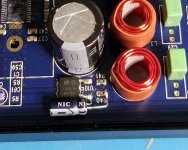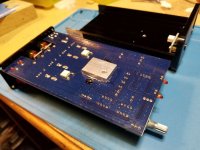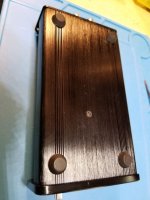jigglebones and chermann, can I check please - you're talking about the FX-502SPRO, right?I tried again setting my PSU to 28V and compare to 24V.....and I do prefer the 24V, sounds better and cleaner less offensive to my ear.
I have a newly arrived TPA3250 EVM, and I think I read that it's best with a 30V supply? Do you know?
I was intending to order the 30V version of the Connex SMPS300RS.
the 2nd pic you can see the parallel wima caps 150nF/63V to the 1800µF Rubycon -back side.
chris
Has something really improved with those capacitors? And which value of nF better to install?
jigglebones and chermann, can I check please - you're talking about the FX-502SPRO, right?
I have a newly arrived TPA3250 EVM, and I think I read that it's best with a 30V supply? Do you know?
I was intending to order the 30V version of the Connex SMPS300RS.
For the TPA3250 EVM board, 30V good, 36V better. That's certainly my experience, and a few others over on AudioKarma.
Last edited:
Thanks Yatsushiro. Your information reinforces what I had already heard - that the EVM boards are sounding best in the upper range of their input voltage specification.
So I will buy a 32V Connex supply (probably the SMPS320RxE) because initially I want to try it in combination with a capacitance multiplier which has an upper limit of 33V.
If I discover that the amp sounds no better with the cap multiplier, I will remove it, then adjust the voltage on the Connex to its highest setting, which is likely to be about 34V.
So I will buy a 32V Connex supply (probably the SMPS320RxE) because initially I want to try it in combination with a capacitance multiplier which has an upper limit of 33V.
If I discover that the amp sounds no better with the cap multiplier, I will remove it, then adjust the voltage on the Connex to its highest setting, which is likely to be about 34V.
jigglebones and chermann, can I check please - you're talking about the FX-502SPRO, right?
I have a newly arrived TPA3250 EVM, and I think I read that it's best with a 30V supply? Do you know?
I was intending to order the 30V version of the Connex SMPS300RS.
Hi
Yes i am talking about the FX502S Pro. there is the implementation of TPA3250 chip.
I my idea i try to keep the original psu to test what level of SQ vs Money i got here. 😉
watch out the chip can handle more Voltlage 38v -than the caps inside !
as you can read from page 30 -up to now i think that this little amp is very good in SQ -better with
changing Opamp instead of original
if you use 24V psu- the LM317 is not correct configured -so change it.
page 52 #521
the original psu is pushing 4-5 continiously ...up to 5.6 Amps (page 47 #463) so not bad but i think a stronger = 200-300W will give better SQ
more "cooling" ---> check the page 49 #484
chris
Has something really improved with those capacitors? And which value of nF better to install?
Hi noasds
for me there is no need to change the rubycon caps...They look original
page 32 #327
page 39 #390
the other smal caps = i follow the rule as discribed in:
EEVblog #859 - Bypass Capacitor Tutorial to mix the different technology of caps to "catch" more ripple 😀
chris
Last edited:
Yes, I see that's an issue with the FX-502SPRO, but no problem with the TPA3250 EVM - all caps at the DC input are 50V.watch out the chip can handle more voltage 38v - than the caps inside!
It would be good to give all the changes, step by step with explanations and pictures in one post.
sorry zek
but actually my time for audio is limited more than the previous month....holidays kids....so please take your time to start reading from very beginning of this thread to get more information and learn by my mistakes and measurements as good as i can...as a noob...🙂
#646 is a short summary...
and actually i try to go ahead with the TPA3255 ...what is wrong with TPa3255..
What is wrong with TPA3255?
kr
chris
Last edited:
..... and learn by my mistakes and measurements as good as i can...as a noob...🙂
Yeah, as I can see, you made one good step, and two mistakes - very difficult to follow, but I would try.😀
Yeah, as I can see, you made one good step, and two mistakes - very difficult to follow, but I would try.😀
yes that´s DIY 😀😉
my FX502 V3 gives a loud off-pop, not sure what is the cause?
(am running it off a SMPS of 31~32 volts)[/QUOTE]
sorry forestsgump...
Did you change the caps near the LM317? LM317 is able to handle up to 37V...so it should be fine.
as doctor wrote me : a pop on /off noise i because of quick impedance/voltage drop up/down.....
Have you checked some components or/and voltages?
do not use your fine listening speakers -use a cheap speaker chassis
if i tested the fx502spro this IRF9530N is strange : for voltage protection or what ever..because nobody knows really what for😀
(am running it off a SMPS of 31~32 volts)[/QUOTE]
sorry forestsgump...
Did you change the caps near the LM317? LM317 is able to handle up to 37V...so it should be fine.
as doctor wrote me : a pop on /off noise i because of quick impedance/voltage drop up/down.....
Have you checked some components or/and voltages?
do not use your fine listening speakers -use a cheap speaker chassis
if i tested the fx502spro this IRF9530N is strange : for voltage protection or what ever..because nobody knows really what for😀
Chris, you felt FX502 V3 design had adequately muted on/off pop sound?
I dint change any caps around the LM317, since I only running 31~32v. Is it neccessary to change?
Not sure where to check for.
I dint change any caps around the LM317, since I only running 31~32v. Is it neccessary to change?
Not sure where to check for.
Chris, you felt FX502 V3 design had adequately muted on/off pop sound?
I dint change any caps around the M317, since I only running 31~32v. Is it neccessary to change?
Not sure where to check for.
hi forestsgump
during my test i am not able to differ the V3 vs. V5 version--> so its the same for me.
the pop noise is coming from not holding the reset = pin 18 RESET during power up/down.
..but where and why on this board i do not know. without clear layout doctormord cant help i guess...
read the datasheet : TI TPA3250 chapter 11.2 + 11.3 carefully...
...and try to measure at this pin durin switch on/off and at the voltage psu
chris
Last edited:
...some ideas for new coils...
if you want to Change the output Lc filter of the fx502Spro .....here are some ideas. please take into account that the board will be closed wiht the alu case...so not much room for big fat coils 😀😉
chris
if you want to Change the output Lc filter of the fx502Spro .....here are some ideas. please take into account that the board will be closed wiht the alu case...so not much room for big fat coils 😀😉
chris
Attachments
I bought my FX502SPRO back at the start of May, but just happened on this thread yesterday and immediately spent a number of hours reading every post across (now) 66 pages! So first I have to thank everyone who gave input here, especially @chermann for your detailed investigations.
So I have a couple of questions that I've not seen answered or posited yet:
1) (excuse my ClassD ignorance) Is it possible to bridge these amps so that I could form two, more powerful, monoblocks from two of them?
2) And/Or rather than worry about the power supply/OpAmp rolling, has anyone looked in to bypassing the OpAmp/volume sections entirely? I want to feed this/these directly from a regular preamp, which makes these stages redundant and just more risk of audio degradation.
Thanks again to all!
So I have a couple of questions that I've not seen answered or posited yet:
1) (excuse my ClassD ignorance) Is it possible to bridge these amps so that I could form two, more powerful, monoblocks from two of them?
2) And/Or rather than worry about the power supply/OpAmp rolling, has anyone looked in to bypassing the OpAmp/volume sections entirely? I want to feed this/these directly from a regular preamp, which makes these stages redundant and just more risk of audio degradation.
Thanks again to all!
meq123, since no one else has answered your questions, I will jump in. Bear in mind there are people here with expertise way beyond my own.
The TPA3250 (and 3251 and 3255) has 4 active stages, and can be configured in several different input/output modes:
i) The recommended, and usually default, mode is 2 channel differential input, BTL output. Each differential input half uses an amplifier stage.
Apparently these amps measure best in this configuration, and this is what you want for best SQ. The FX502S PRO is set up this way. So you may wonder why the FX502S PRO has stereo single-ended inputs ... more on this later.
ii) or each of the 4 stages can be fed by separate single-ended inputs, so that the amp is 4 channel.
iii) for mono input/output, the output stages can be configured for parallel BTL (PBTL). The mono input will be differential.
iv) you can configure two stages for SE, and the remaining two stages for BTL, for a 2.1 configuration.
If your aim is best SQ, and that's not entirely clear from my reading of your post, then you want 2 channel diff input, BTL output, which the FX502S PRO already gives you. Be aware that the input stage of the FX502S PRO converts single-ended inputs to differential, before passing this on to the TPA3250 chip.
So the input stage can be considered redundant only if your source, preamp or otherwise, is differential. Sure, some of us here are experimenting with bypassing the input stage, but we have differential sources.
Then there are "tinkerers" here who want to stick with a SE source, so are experimenting with better SE-diff input stages. I'm quite interested to hear of developments in this area, and in particular I'm curious to know why no one has so far tried the well regarded differential line drivers such as THAT1606, DRV134, or SSM2142.
In summary, I understand that the FX502S PRO is a good bang-for-buck amplifier, but if you're looking for better/best sound quality, I think you should step up to a better implementation of the TPA3250, such as the EVM or 3e-audio board.
And if you want good SQ and more power, move up to the TPA3251 or TPA3255 - again, either EVM or 3e-audio board.
The TPA3250 (and 3251 and 3255) has 4 active stages, and can be configured in several different input/output modes:
i) The recommended, and usually default, mode is 2 channel differential input, BTL output. Each differential input half uses an amplifier stage.
Apparently these amps measure best in this configuration, and this is what you want for best SQ. The FX502S PRO is set up this way. So you may wonder why the FX502S PRO has stereo single-ended inputs ... more on this later.
ii) or each of the 4 stages can be fed by separate single-ended inputs, so that the amp is 4 channel.
iii) for mono input/output, the output stages can be configured for parallel BTL (PBTL). The mono input will be differential.
iv) you can configure two stages for SE, and the remaining two stages for BTL, for a 2.1 configuration.
If your aim is best SQ, and that's not entirely clear from my reading of your post, then you want 2 channel diff input, BTL output, which the FX502S PRO already gives you. Be aware that the input stage of the FX502S PRO converts single-ended inputs to differential, before passing this on to the TPA3250 chip.
So the input stage can be considered redundant only if your source, preamp or otherwise, is differential. Sure, some of us here are experimenting with bypassing the input stage, but we have differential sources.
Then there are "tinkerers" here who want to stick with a SE source, so are experimenting with better SE-diff input stages. I'm quite interested to hear of developments in this area, and in particular I'm curious to know why no one has so far tried the well regarded differential line drivers such as THAT1606, DRV134, or SSM2142.
In summary, I understand that the FX502S PRO is a good bang-for-buck amplifier, but if you're looking for better/best sound quality, I think you should step up to a better implementation of the TPA3250, such as the EVM or 3e-audio board.
And if you want good SQ and more power, move up to the TPA3251 or TPA3255 - again, either EVM or 3e-audio board.
Oops, forgot to address this question -
- but you would need to study the datasheet carefully to work out what wiring changes are necessary, and I suspect it may be tricky to execute these changes on the FX502SPRO circuit board,
- and here's the kicker - PBTL mode is only suitable for speakers in 2 - 4 ohm range.
Again, if you want more power - go for the TPA3251 or 3255.
Yes, in PBTL mode, as I listed above ...Is it possible to bridge these amps so that I could form two, more powerful, monoblocks from two of them?
- but you would need to study the datasheet carefully to work out what wiring changes are necessary, and I suspect it may be tricky to execute these changes on the FX502SPRO circuit board,
- and here's the kicker - PBTL mode is only suitable for speakers in 2 - 4 ohm range.
Again, if you want more power - go for the TPA3251 or 3255.
meq123, since no one else has answered your questions, I will jump in.
Excellent and very clear response, thank you!
Yes, I found the data sheet after I posted and saw it talk about the different modes and the implication that PBTL was for only 2-4ohm speakers, but it didn't seem absolute - so thanks for the clarification. I certainly didn't realise the about the diff input nature of the chip, so that explains that!
OK, so I'll leave the general layout as-is. Thanks again.
Last edited:
Thanks to this thread, I went ahead and modified my Amp as per posts by @chermann and @irribeo.
I replaced the LM317 resistor with another 0805 surface mount 3k6 and soldered the cap across it - as shown in pic 1. Pic 2 shows the extra heatsink and bypass caps in place. I cut a rectangle from an old (dead) PC PSU heatsink that was the perfect depth, then glued it in place with heatsink epoxy sandwiched with a silicone transistor heatsink pad to isolate it from the PCB. I cut around an existing threaded hole in the heatsink and used that to attach to the bottom of the case (took some very careful measuring to get the hole in the case correctly!).
Anyway, all works now, though not had time to do any real listening tests. Thanks again to all.
I replaced the LM317 resistor with another 0805 surface mount 3k6 and soldered the cap across it - as shown in pic 1. Pic 2 shows the extra heatsink and bypass caps in place. I cut a rectangle from an old (dead) PC PSU heatsink that was the perfect depth, then glued it in place with heatsink epoxy sandwiched with a silicone transistor heatsink pad to isolate it from the PCB. I cut around an existing threaded hole in the heatsink and used that to attach to the bottom of the case (took some very careful measuring to get the hole in the case correctly!).
Anyway, all works now, though not had time to do any real listening tests. Thanks again to all.
Attachments
- Home
- Amplifiers
- Class D
- TPA3250 somebody is listening?


